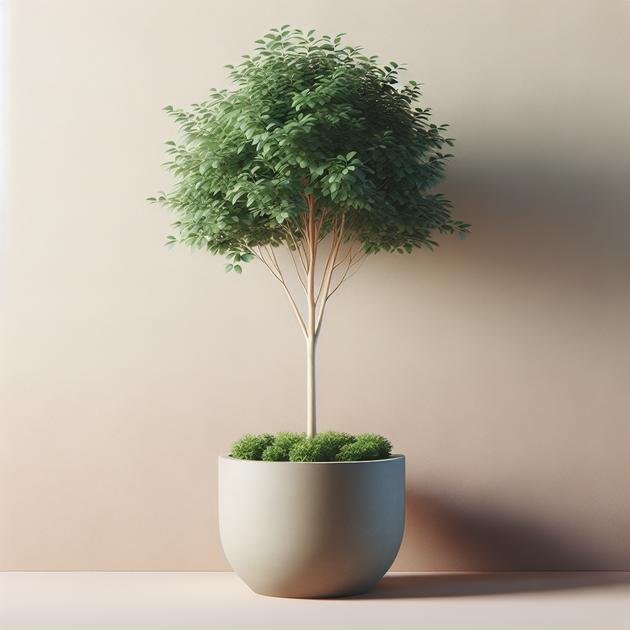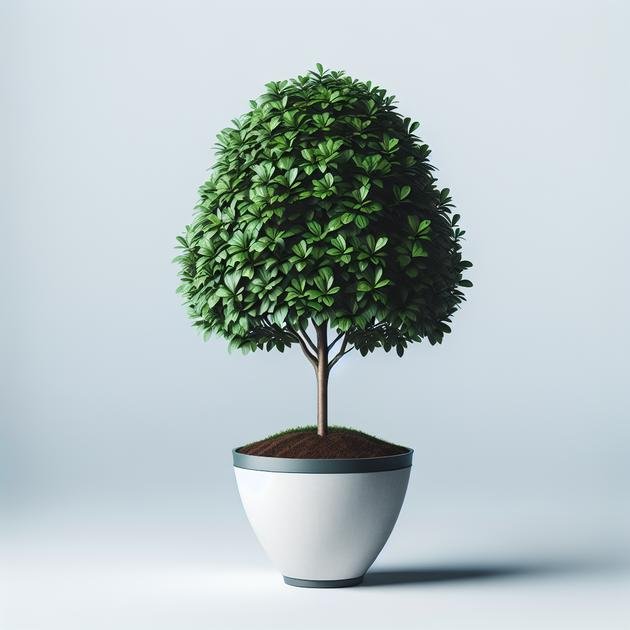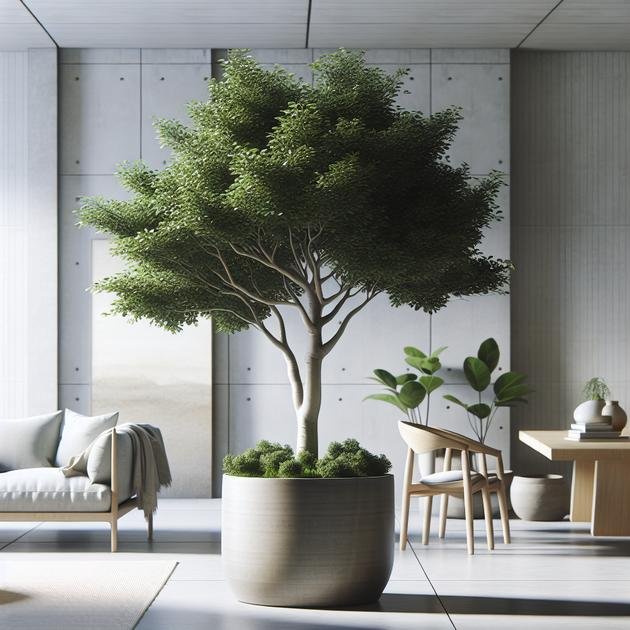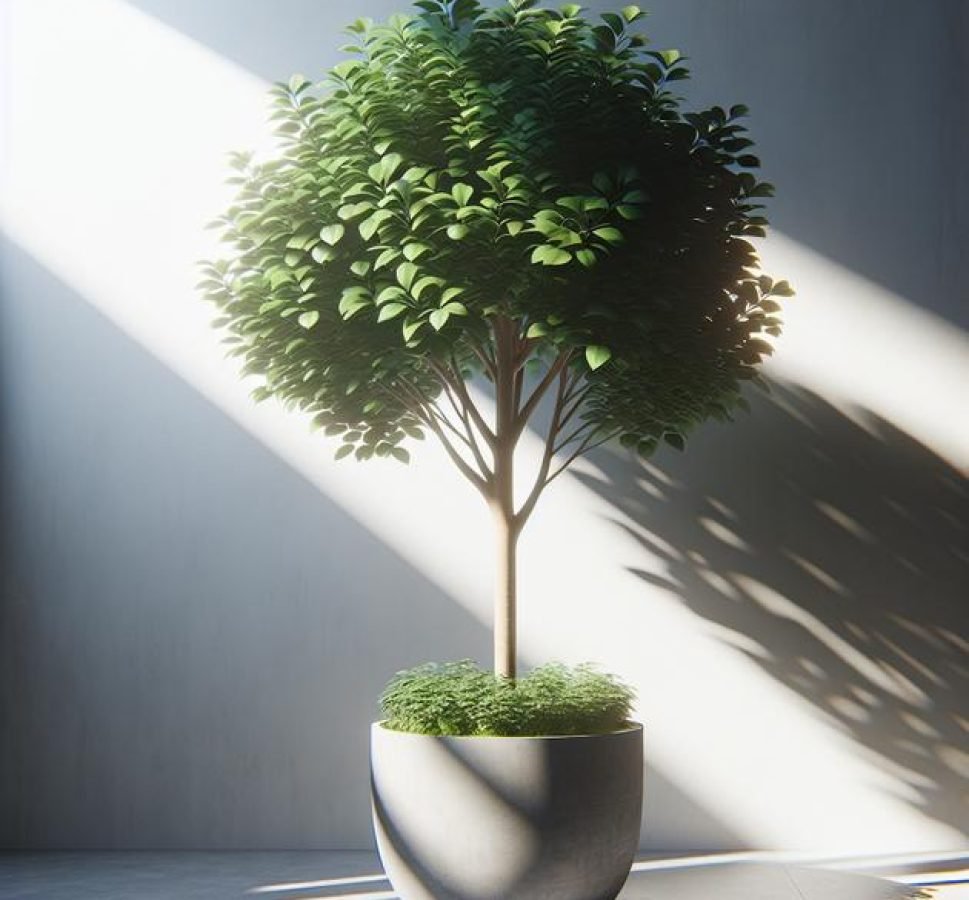Potted tree inspiration involves selecting suitable trees, pots, and placements that combine aesthetic appeal with proper care to enhance indoor and outdoor spaces effectively.
If you’ve ever wondered how to bring green charm to your home, potted tree inspiration might be just the spark you need. Curious how these leafy beauties can transform your space? Let’s explore ideas that blend style and nature effortlessly.
choosing the right pot for your tree
Choosing the right pot for your potted tree is crucial for its growth and appearance. Start by considering the size of the tree; the pot should be large enough to allow roots to spread comfortably but not too big, which can lead to water retention issues. Drainage holes are essential to prevent waterlogging and root rot, so always select pots with good drainage.
The material of the pot also matters. Terracotta pots are porous and help in evaporating excess moisture, making them great for trees needing drier soil. Plastic pots retain moisture better and are lightweight, ideal for moving your tree around. Ceramic pots add a decorative touch but may be heavier and need proper drainage.
Shape and style should complement your space and the tree itself. Tall pots work well with taller trees, offering stability, while wide, shallow pots suit trees with spreading roots. Consider color as well, choosing tones that either contrast or harmonize with the tree and your decor.
Pot Selection Tips
- Measure the root ball and add 2-4 inches for pot size.
- Ensure at least one drainage hole at the bottom.
- Use a saucer to catch excess water.
- Choose material based on watering needs and portability.
- Match pot aesthetics with your interior or exterior design.
best trees for indoor pots
When selecting the best trees for indoor pots, consider species that tolerate lower light and indoor conditions well. Popular choices include the Fiddle Leaf Fig, which has large, attractive leaves and thrives in bright, indirect light. Another excellent option is the Rubber Tree, known for its glossy leaves and ability to adapt to varying light levels.
The Parlor Palm is perfect for adding a tropical touch; it is low-maintenance and does well in moderate light. For those who want something more unique, the Bird of Paradise can bring dramatic, large leaves and even flowers if cared for properly.
Considerations for Indoor Trees
- Choose trees that fit your lighting conditions and space size.
- Opt for slow-growing trees to minimize repotting needs.
- Watering routines should align with the tree’s needs — some prefer consistently moist soil, others like it to dry out.
- Look for trees that improve indoor air quality.
- Ensure the tree’s mature size fits your indoor environment.
Indoor trees not only beautify spaces but can provide psychological benefits like improved mood and air purification. Selecting the right species means your potted tree will thrive and become a lasting part of your home decor.
how to care for potted trees
Caring for potted trees involves meeting their basic needs while paying attention to specific details that keep them healthy. Watering is key—most potted trees prefer consistent moisture but dislike sitting in water. Check the soil regularly; water when the top inch feels dry, ensuring excess water drains out.
Lighting is another important factor. Most indoor potted trees thrive in bright, indirect light, though some species tolerate low light. Rotate your tree every few weeks to ensure even growth and prevent leaning toward the light source.
Fertilizing and Pruning
Use a balanced, slow-release fertilizer during the growing season to nourish your tree. Avoid overfeeding as excess nutrients can harm the roots. Pruning helps shape the tree and remove dead or yellowing leaves. Use clean, sharp tools to prevent infections.
Keeping the environment humid can benefit many indoor trees, especially in dry homes. You can mist the leaves or use a humidity tray filled with water and pebbles underneath the pot.
Repotting Tips
Repot your tree every 2-3 years or when roots outgrow the current pot. Select a slightly larger pot with drainage holes and fresh soil. Gently loosen the roots before placing it into the new container, and water lightly to help it settle.
styling potted trees in living rooms

Styling potted trees in living rooms adds life and a natural touch to your home decor. Start by choosing a pot that complements the room’s style; a sleek ceramic pot works well in modern spaces, while rustic terracotta suits boho or farmhouse aesthetics. Placement is key—near windows for natural light, but not in direct harsh sunlight that could scorch leaves.
Grouping potted trees with smaller plants creates layers and depth. Consider varying heights and textures to build visual interest. Use stands or decorative stools to elevate some pots and add dimension.
Tips for Styling
- Keep pathways clear to avoid accidents and create an open feel.
- Add complementary elements like woven baskets or natural fiber rugs to enhance the plant area.
- Incorporate furniture with wood or metal finishes that harmonize with your pots.
- Use lighting, such as floor lamps or string lights, to highlight your plant display after dark.
- Mix in art or mirrors behind plants to reflect light and make the space feel larger.
Remember, a well-styled potted tree not only beautifies your living room but also promotes a calming atmosphere and cleaner air. Regularly rotate the tree to encourage even growth and maintain its vibrant appearance.
using potted trees in small spaces
Using potted trees in small spaces can transform cramped areas into refreshing green havens. Choose slim or compact tree varieties like the Snake Plant, Fig Tree, or Dwarf Citrus Trees that don’t take up much room but still make an impact. Placing a tree in a corner or next to a window maximizes space and light.
Vertical space can also be utilized by selecting tall, narrow pots or multi-level plant stands to display your trees without crowding the floor. Opt for light-colored pots to keep the area feeling open and airy. Mirrors opposite windows help reflect light and create a sense of depth.
Tips for Small Space Styling
- Pocket pots with wheels for easy movement and flexibility.
- Group plants to form a mini indoor garden without overwhelming the space.
- Choose trees with slender trunks and small leaves to avoid bulkiness.
- Use window sills or shelves for small potted trees to save floor space.
- Consider hanging planters for trailing plants paired with upright trees.
Caring for potted trees in small spaces means minding light and avoiding overcrowding to ensure healthy growth. Regular pruning keeps your tree neat and thriving indoors.
seasonal care tips for potted trees
Seasonal care for potted trees is important to keep them healthy year-round. During spring and summer, trees typically need more water as they actively grow. Increase watering frequency, but always check the soil moisture to avoid overwatering. Apply a balanced fertilizer every 4-6 weeks to support new growth.
In fall, reduce watering gradually as the tree prepares for dormancy. Pruning during this time helps remove dead branches and shapes the tree for the next growing season. Clean leaves and debris from the soil surface to prevent pests.
Winter Care Tips
Indoor potted trees need less water in winter, sometimes only once every two weeks. Keep the tree away from cold drafts and heating vents that can dry out the leaves. Increase humidity by misting leaves or using a humidifier.
Check for pests regularly, especially in winter when trees may be weakened. Use gentle, natural pest controls like neem oil if needed. Repotting is best done in early spring, not during cold months.
Adjusting care routines with the seasons ensures your potted tree stays vibrant and strong, adapting to changing light, temperature, and moisture conditions.
combining pots and furniture decor
Combining pots and furniture decor creates a harmonious and stylish environment for your potted trees. Start by matching the pot’s material and color to your furniture—wooden pots pair beautifully with wooden tables or shelves, while ceramic or metal pots complement modern furniture styles. Texture and finish play an important role; a matte pot can balance glossy furniture, while textured pots add visual interest.
Use furniture pieces like plant stands, small tables, or shelves to elevate plants and integrate them naturally into your living space. Grouping potted trees near accent chairs or by sofas creates a cozy nook that feels inviting and lively.
Design Tips
- Choose pots that contrast or coordinate with furniture colors for balance.
- Place pots on decorative trays or woven mats to add layers.
- Incorporate natural materials like rattan baskets or wooden crates with your pots.
- Use varying heights and sizes of pots and furniture to add dimension.
- Consider lighting to spotlight combined decor and create atmosphere.
The right combination of pots and furniture not only highlights your potted trees but also enhances your room’s overall aesthetic and comfort.
potted tree placement for natural light

Placing your potted tree where it gets the right amount of natural light is essential for healthy growth. Most indoor trees thrive in bright, indirect light rather than direct sunlight, which can scorch their leaves. Spaces near east or west-facing windows are ideal, offering gentle morning or afternoon sun.
Observe your tree’s response to light by checking leaf color and growth patterns. Pale or dropping leaves might indicate too much sun, while slow growth and lean stems often mean not enough light.
Tips for Optimal Placement
- Rotate the tree regularly so all sides receive light evenly.
- Use sheers or curtains to filter harsh sunlight.
- Avoid placing trees too close to cold drafts or heating vents, which can stress the plant.
- Consider supplemental grow lights if natural light is limited.
Balancing natural light exposure with your potted tree’s needs helps maintain lush foliage and vibrant health, enhancing your indoor space beautifully.
watering tips for healthy potted trees
Watering is a vital part of keeping potted trees healthy, but it requires careful attention. Most potted trees prefer the soil to dry slightly between waterings. Insert your finger about an inch into the soil; if it feels dry, it’s time to water.
Overwatering can lead to root rot, while underwatering causes leaf drop and poor growth. Use pots with drainage holes to allow excess water to escape and prevent waterlogged soil.
Watering Techniques
- Water slowly and evenly around the base of the tree to ensure deep absorption.
- Avoid wetting the foliage to reduce the risk of fungal diseases.
- In warmer months, you may need to water more frequently; adjust based on your tree’s needs.
- Use room temperature water to avoid shocking the roots.
- Consider self-watering pots or bottom watering methods for consistent moisture.
Observing your tree’s response after watering helps you find the right balance. Healthy leaves, steady growth, and moist but not soggy soil indicate proper watering practices.
common mistakes with potted trees
Many people make common mistakes that affect the health of their potted trees. One frequent error is overwatering, which can lead to root rot and yellowing leaves. Avoid watering on fixed schedules—check the soil moisture before adding water.
Another mistake is placing the tree in unsuitable lighting. Too much direct sunlight can scorch leaves, while too little light causes weak, leggy growth. Find the right balance based on your tree species.
Other frequent pitfalls
- Using pots without drainage holes, which traps water and harms roots.
- Ignoring proper fertilization; lack of nutrients slows growth.
- Failing to repot when roots outgrow their container, leading to stress.
- Neglecting pest control, allowing infestations that damage the tree.
- Overcrowding multiple plants in one pot, restricting growth space.
Awareness of these mistakes and how to avoid them ensures your potted tree stays healthy and vibrant for years.
using potted trees to improve air quality
Potted trees are not only decorative but also powerful natural air purifiers. They can remove toxins and improve indoor air quality by absorbing pollutants and releasing oxygen. Common trees like the Ficus, Areca Palm, and Rubber Tree are especially effective at filtering harmful chemicals such as formaldehyde and benzene.
Keeping your potted trees healthy is essential to maximize these benefits. Regular dusting of leaves helps open up pores for better air absorption. Avoid overusing chemicals near your plants, as they can reduce their filtering abilities.
Best Practices
- Choose varieties known for air purification.
- Place trees in high-traffic indoor areas for maximum effect.
- Ensure adequate light and water to keep trees thriving.
- Combine different plants to tackle a wider range of pollutants.
- Rotate plants occasionally to promote even growth and air filtration.
Integrating potted trees into your living or work space not only brightens the environment but supports cleaner, healthier air for everyone.
potted trees for office environments

Potted trees are excellent additions to office environments, adding greenery that boosts mood and productivity. Choose low-maintenance trees such as the Snake Plant, Zanzibar Gem, or Fiddle Leaf Fig that thrive indoors and tolerate varying light conditions.
Position trees near windows or spaces with indirect light to keep them healthy. Avoid placing them where they may obstruct walkways or workspace. Using decorative pots that match the office decor can unify the environment and create a welcoming atmosphere.
Benefits of Office Potted Trees
- Improve air quality by filtering indoor pollutants.
- Reduce stress and increase focus and creativity.
- Add a natural vibe that enhances overall workplace aesthetics.
- Provide privacy screens or noise dampening in open offices.
Regular care is essential: water moderately, dust leaves to keep pores open, and prune dead foliage. Incorporating potted trees thoughtfully can transform office spaces into greener, healthier places to work.
creative ways to group potted trees
Grouping potted trees creatively can enhance the visual impact and make your space more inviting. Start by mixing different tree sizes and shapes to create layers and depth. Tall trees can serve as focal points, while smaller trees fill in gaps and soften edges.
Use plant stands and shelves to add height variation and avoid a crowded look. Grouping trees with complementary foliage colors and textures adds contrast and interest.
Tips for Grouping Potted Trees
- Arrange trees in odd numbers for a natural, balanced appearance.
- Use matching or complementary pots to unify the group visually.
- Consider lighting; place groups where light reaches all plants evenly.
- Incorporate other decorative elements like stones, moss, or small sculptures.
- Rotate trees regularly to ensure even growth and exposure.
Whether placed indoors or outdoors, thoughtfully grouped potted trees can become a stunning centerpiece that transforms any space.
repotting tips and when to do it
Repotting your potted tree is important for its continued healthy growth. Trees need fresh soil and more space for roots as they mature. Typically, repotting is best done every 2-3 years or when roots start growing out of the drainage holes.
Signs it’s time to repot include slowed growth, water draining quickly without soaking the soil, or visible root crowding. Choose a pot that is 2-4 inches larger in diameter than the current one to give roots room to expand.
Repotting Steps
- Water the tree a day before repotting to reduce stress.
- Gently remove the tree from its pot without damaging the roots.
- Loosen the root ball lightly, trimming any dead or circling roots.
- Place a layer of fresh potting soil at the bottom of the new pot.
- Position the tree in the new pot, filling around it with soil while keeping the tree upright.
- Water lightly after repotting to help the soil settle.
Avoid repotting during the tree’s dormant season; early spring is ideal. Proper repotting supports stronger roots, better nutrient absorption, and healthier foliage.
incorporating potted trees in outdoor patios
Incorporating potted trees in outdoor patios adds natural beauty and creates a relaxing atmosphere. Select trees that thrive outdoors, such as citrus trees, olive trees, or small palms. Choose pots that complement your patio’s style—terracotta or stone pots add a classic look, while sleek ceramic pots fit modern spaces.
Placement is key to make the most of your patio space. Position taller trees in corners to frame the area, while smaller trees can line pathways or sit beside seating areas. Using different pot heights and grouping trees can add depth.
Care and Styling Tips
- Ensure pots have proper drainage to prevent water accumulation.
- Water regularly, considering seasonal weather changes.
- Use mulch on the soil surface to retain moisture and reduce weeds.
- Add outdoor-friendly furniture and accessories that complement your plants.
- Consider lighting options like string lights or lanterns to highlight trees at night.
With thoughtful placement and care, potted trees can transform your outdoor patio into a refreshing retreat.
Bringing It All Together
Potted trees offer a wonderful way to add greenery and life to any space, whether indoors or outdoors. By choosing the right trees, pots, and placement, and by following simple care tips, you can create a beautiful and healthy environment that brightens your home or patio.
Remember, each tree has its own needs, so paying attention to watering, light, and seasonal care will help your plants thrive. With creativity and a little effort, potted trees can become stunning focal points and improve your space in many ways.
Embrace the joy of nurturing plants and enjoy the fresh atmosphere and natural beauty they bring into your life.





